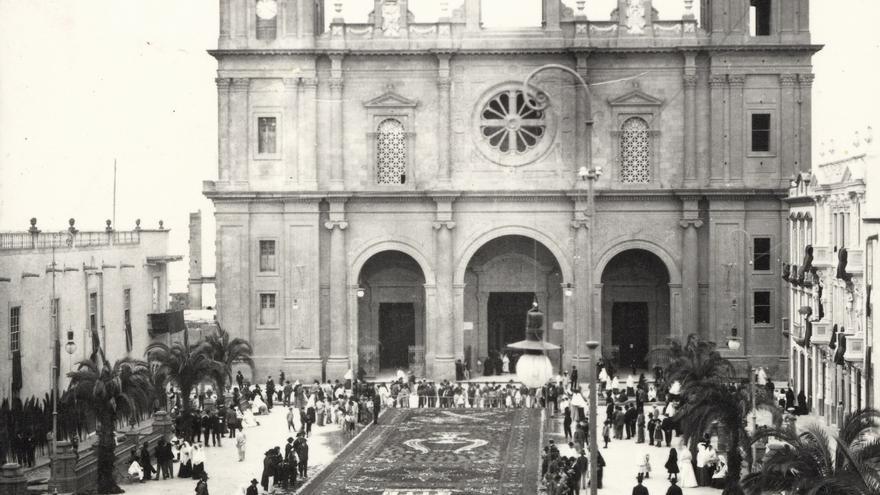
He had the same trade as Saint Joseph, but the greed of Judas Iscariot. With these ingredients, a natural woodpecker from La Laguna (Tenerife) He arrived in Gran Canaria by boat in December 1947 with a carefully studied plan: to steal the treasure from the Cathedral of Santa Ana. After spending the night in the temple, he accessed the jewelery closet. The next morning, he left for the neighboring island with a sack and a suitcase. But the police stopped him before the ship sailed.
At nine twenty in the morning of Thursday, December 4, 1947, 62 years ago, the canons of the Holy Cathedral Church, Mr. Alexander Ponce Arias and Don Thomas Ventura, honored the Investigation and Surveillance Police Station of the Las Palmas de Gran Canaria Police Department with their presence. They arrived there to report on the sacrilegious robbery that had been committed in the cathedral temple of Gran Canaria.
The ecclesiastics declared that that morning they noticed that the cabinet where the religious jewels were kept showed unmistakable signs of having been forced and, of course, there was no trace of the valuable jewels. The police approached the Cathedral soon after and carried out a thorough investigation.
Agents noted that the thief had drilled three doors with a brace and that with the help of a drill and a saw, he managed to open a small hole and break the locks to access the place where the treasure was kept.
Once the inspection was carried out, the chief inspector of the Criminal Brigade, Mr. Luis Abienzo Gomez and the agent don Eduardo Sanchiz Candela, to whom the accidental chief inspector of the Police Station, Mr. Ildefonso Castro Ascanio, proceeded to carry out the appropriate steps aimed at capture the perpetrator, being arrested after two hours Anthony Gonzalez Afonso, native and resident of La Laguna (Tenerife), a carpenter by profession, 34 years old and single.
He was arrested at the precise moment when he was about to board the steamship León y Castillo, which was setting sail for Tenerife that morning..
After being subjected to intense interrogation, Antonio González confessed to the robbery, taking care of all the stolen jewelry. The police learned later that the thief had already tried to secure his 1947 Christmas dinner several weeks in advance. And it seems that to facilitate such a succulent project he had no problem bringing his carpentry tools, a week before committing the robbery. , and spend a night in the Cathedral.
As he confessed, on different occasions he had traveled to this capital to finalize the details of his operation. To that effect, visited the Cathedral, joining a group of tourists.
There he carefully saw the place where the jewels were kept. Then it was a matter of studying the best procedure to get hold of them.
mock surveillance
On the afternoon of that Wednesday, Antonio González circumvented the vigilance of those in charge of closing the Cathedral, who made the usual review without noticing that someone had hidden behind the altar of the Tabernacle, located in the left nave of the temple. There he waited until nightfall, when the Cathedral closed. Then, calmly, the carpenter took out his work tools and got to work.
The next morning, when the doors of the cathedral temple opened again, he left the enclosure through the main door, heading for Puerto de La Luz. The jewels were carried inside a suitcase, while a small sack contained two chisels, pliers and a screwdriver.
In the Cathedral left the thief abandoned a black mask and brace. Antonio González, convicted and confessed, entered the city’s provincial prison that day.
A Cellini peacekeeper
The stolen jewels had a priceless artistic and historical value, because among them was a beautiful peace holder made of gold, precious stones and enamels, by the Florentine sculptor Benvenuto Cellini (1500-1571), one of the most important goldsmiths of the Renaissance. In the booty were also found the two gold medals that the Royal Spanish Academy gave to the historian and writer José Viera y Clavijo (1731-1813), one of the greatest representatives of the Canarian Enlightenment and a pectoral cross that belonged to the Canarian bishop Verdugo, with emeralds and diamonds.
In addition to a rose window with emeralds and diamonds and a pastoral ring. The jewels and other objects of the cult were valued at about 500,000 pesetas at the time.
The governor congratulated the Police for the quick arrest
After resolving the event, the civil governor of Las Palmas, Mr. Jose de Olague-Arnedo, provided that Friday, December 5, 1947, the following note, through his secretary:
“On the occasion of the sacrilegious robbery committed at dawn today in the Santa Iglesia Catedral Basílica, in which the author of the act, Antonio González Afonso, seized numerous jewels and other objects of worship valued at 500,000 pesetas, which were recovered at Within a few hours of that fact, I am very pleased to pay tribute and make public my most sincere congratulations to the staff of the General Police Corps of Las Palmas, whose chiefs and agents set up and developed the corresponding service with plausible enthusiasm and professional zeal, who As a result, as has been said, the almost immediate recovery of the valuable stolen objects.
Las Palmas de Gran Canaria, December 4, 1947. The Governor.”
It was a robbery gave a lot to talk about in Gran Canarian society at the time. That same day, the deacons of the Cathedral commissioned the purchase of a new wardrobe, which naturally was not included in the budget and they carried out a lot of other precautions so that the crooks would have a harder time in the house of the Lord.
Other historical events
If this event that is part of the Black Chronicle of the Canary Islands, you liked it, here you have others to continue delving into the crimes of the history of the Canary Islands.
















